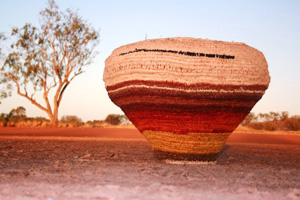
Pantjiti Mackenzie – Basketpa Tjukulangati (Deep rockhole basket), 2009
Image courtesy and © Tjanpi Desert Weavers, NPY Women’s Council
Photograph: Emma Diamond
Exhibition String theory: Focus on contemporary Australian art: a group exhibition exploring innovative approaches to fibre and art in a contemporary context.
The presentation brings together over 20 Aboriginal artists from across Australia who work with expanded notions of textile and craft-based tradition.
The artists and artist groups presented in the exhibition include: Tony Albert, Jean Baptiste Apuatimi, Boolarng Nangamai Aboriginal Art + Culture Studio, Frances Djulibing, Robyn Djunginy, Lola Greeno, Dale Harding, Thelma Judson, Evelyn McGreen, Lipaki Marlaypa, Dhundunga Mununngurr, Noongar DollMakers, Laurie Nilsen, Alison Page, Regina Pilawuk Wilson, Jimmy Pike, Yarrenyty Arltere Artists, Tjanpi Desert Weavers, Vicky West and Yirrkala Printmakers.
String theory presents a diverse range of works which engage with textile artistic traditions including sculpture, photography, painting and video. The exhibition is fore-grounded by the work of Yirrkala artist Lipaki Marlaypa whose traditional hand-made woven string acts as a conceptual starting point.
A number of works in String theory, such as those from Ramingining and Yirrkala will become part of the MCA Collection and have a direct lineage back to the MCA’s history. One such work, and a pivotal one, a Yukuwa (Yam string vine) by Frances Djulibing is a reprise of an earlier piece that bridges the MCA past and present.
MCA Director Elizabeth Ann Macgregor OBE said: ‘String theory is a multi-disciplinary contemporary tribute to the rich textile tradition of Aboriginal artists and takes as its starting point the way in which the MCA‘s collecting policy has always acknowledged such work as contemporary art.’
A key component of String theory is people: people talking and people making. For example, in Dale Harding’s work, ideas and objects grow out of conversations with the artist’s grandmother and mother, slowly evolving into artworks that tell the hard truths of Australian history.
The Tjanpi Desert Weavers’ tactile environments are a culmination of discussion, travel across vast distances and hands-on work between artists and art workers in communities, cities and towns, non-Indigenous and Indigenous, working together.
The exhibition’s curator Glenn Barkley also said: “string theory is a scientific principle that posits a theory of everything. In the exhibition it implies expansion and connection across time and space, porous and open-ended embracing diverse approaches to the idea of ‘fibre’ or craft-based disciplines”.
Source: Press releases